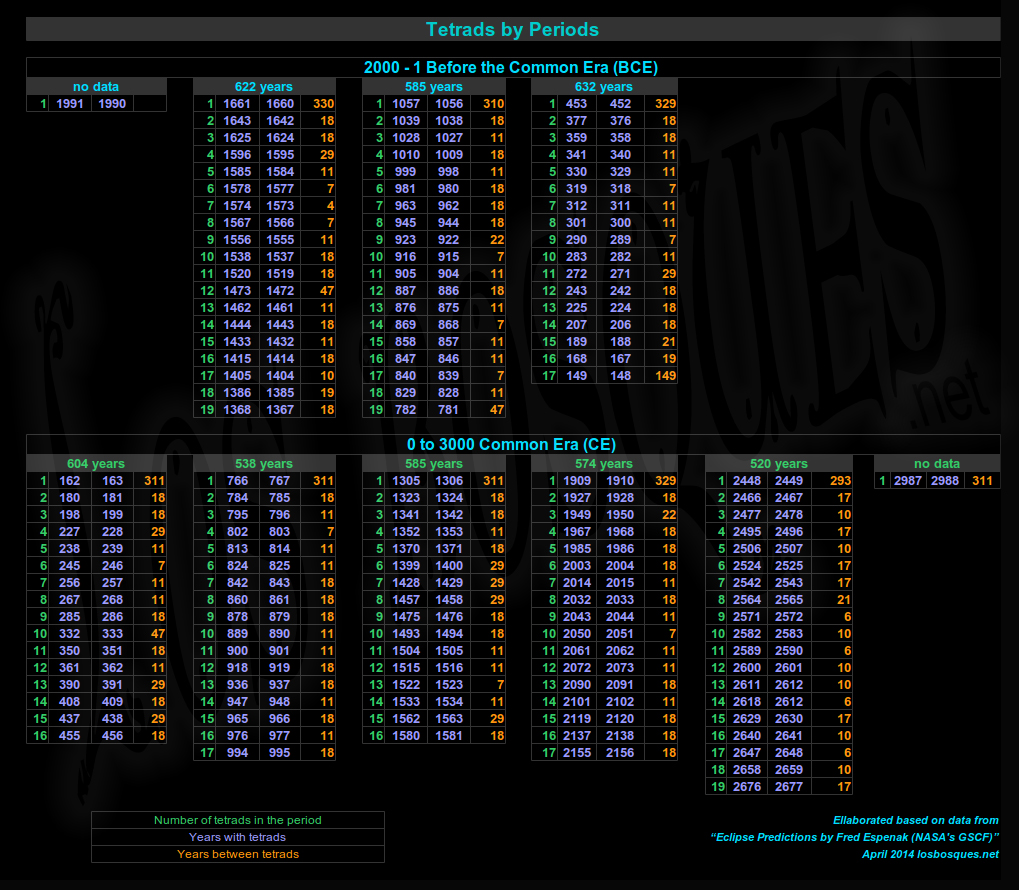- The following Table was organized in eight periods
- Each period with the years without tetrads and years with tetrads
- Starting with the years without tetrads as it happens in cycles governing us: first the dark time

Insufficient Data
- Data is available only for 8 periods of tetrads during the last 5000 years
- Although it seems a great period of time, it’s not enough to understand these cycles of approx +/-600 years each one
- It’s likely their patterns and the mechanics of their cycles are found in much longer periods
- Example, eclipse families (Saros) return in shorter periods (each 18 years) and have a duration of approx. 12 or 13 centuries
- Saros happen each 18 years and complete in 1,000 years approximately. Tetrads happen each 600 years approximately and it’s likely they complete in much more than 5000 years of accessible data
Tetras and the Orbit’s Eccentricity
- Tetrads are linked to the Earth’s eccentricity on its orbit
- However, eccentricity itself is a phenomena without scientific consensus
- There are several positions concerning the causes of this eccentricity
- What is clear is that there is an eccentricity on the orbit
- Eccentricity understood as the degree of deviation on its orbit around the Sun from a complete circle
Variations in Eccentricity
- Eccentricity itself suffers variations in time
- Currently the Earth’s eccentricity is approximately 0.0167
- In hundreds of thousands of years, it varies from 0.0034 to almost 0.058 as a result of gravitational attractions among the planets
Data on Tetrads
Fuente: “Eclipse Predictions by Fred Espenak (NASA’s GSCF)”
- There is a tetrad on lunar total eclipses for 2014 and 2015
- For 2014: April 15 and October 8. For 2015: April 4 and September 28
- The last tetrad was in 2003 and 2004; the next one will be in 2032 and 2033.
- A tetrad has 4 consecutive total lunar eclipses
- In 5000 years (-1999 to +3000) there were 3,479 total lunar eclipses, only 568 (16,32%) were part of tetrads
- And in those 5000 years, there were 142 tetrads
- The ‘season’ of a tetrad is approximately 565 years
- There are no tetrads from 1582 to 1908, a period of 326 years, but there are 17 tetrads for the next two centuries and a half from 1909 to 2156, 247 years
- Variations in time for tetrad ‘seasons’ are related to the slowly decreasing eccentricity in Earth’s orbit in conjunction with eclipses
- Considering this eccentricity is reducing gradually, in a remote future, when this eccentricity is 0, tetrads will not be possible
- Due to precession, during the first millenia, the first eclipse of each tetrad was between February and July. In the next one, the first eclipse of the tetrad will come later in the year
- The umbral magnitudes of the total eclipses making up a tetrad are all relatively small. For the 300-year period 1901 to 2200, the largest umbral magnitude of a tetrad eclipse is 1.4251 on 1949 Apr 13. For comparison, some other total eclipses during this period are much deeper. Two examples are the total eclipses of 2000 Jul 16 and 2029 Jun 26 with umbral magnitudes of 1.7684 and 1.8436, respectively
Read also: